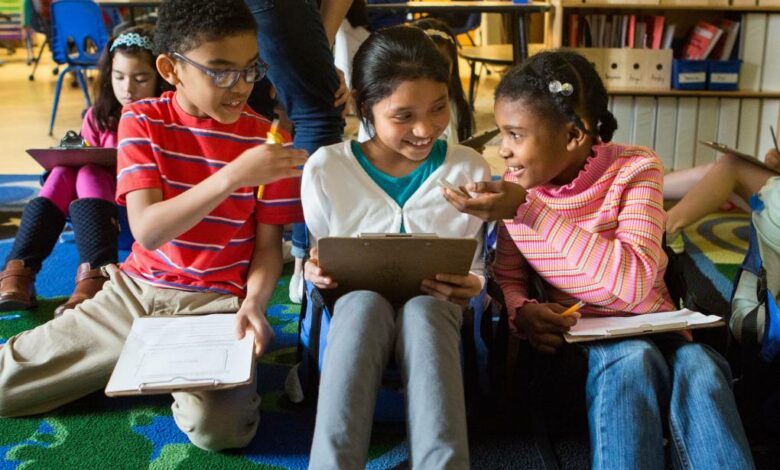When parents know these 4 phases of friendship, they can help their child make friends more easily

Ideally, when parents of very young children make these choices for them, they will share the reasons for their choices with their children. For example, when inviting a child for a playdate, the parent could say something like, “I think you are going to have a good time with Ravi. She always listens to me and shares her playthings with you.” Not only does this sharing of information help children understand their parents’ choices, but it also tells the children what is expected of them.
By the time your child reaches school age, then, he should already have some sense of how to choose a friend. You can imagine him faced with a schoolyard filled with children he doesn’t know on the first day of school. He wants to find someone to play with. Over to his left, a few boys are playing ball and a ball comes loose and rolls toward him. A boy in a Green Bay Packers cap runs after the ball, picks it up and smiles. In that friendly smile, your child senses an invitation. He smiles back and begins walking toward the boy wearing the Packers cap. He has chosen to make a new friend.
2. Initiating
The initiation phase is what happens next. Your child follows his new friend as he joins the three other boys playing ball. He waits until there’s a break in what is going on. “Hi,” he says with a smile. “Can I join in?” The other boys introduce themselves quickly and your child says, “I’m a Packer Backer too. I’ve got a Packers cap at home. I’ll wear it tomorrow.”
The boy with the Packers cap says, “Remember when they won that game when it was a million degrees below zero?” Your child excitedly comments about how the field was like ice, and soon there are five boys happily playing.
For a five-year-old meeting new peers for the first time on a playground, even a seemingly simple interaction like this one is a difficult task involving both nonverbal and verbal behaviors: Your child waited patiently and, sensing the rhythm of the game, chose the right moment to cut in. He didn’t intrude on their game, showing his respect for their personal space. When he did introduce himself, he smiled warmly and made eye contact. Then he made “small talk” before he asked to join in. I think we all can imagine many ways that the interaction could have gone much less successfully than it did.
The initiation phase is when the real give-and-take of social information through nonverbal and verbal channels gets under way. Your child is in uncharted relationship waters now. For the first time, he is running his own show and it is up to him to get this potential relationship off to a successful start.
3. Deepening
Over time, if all goes well, your child’s friendships will deepen in ways that would have been all but impossible in the earlier phases of development, in which friendships are usually fleeting and revolve around a shared activity. Hallmarks of a deepening relationship include trust, self- disclosure, acceptance and mutual understanding. As C. S. Lewis put it: Friendship is born at that moment when one person says to another, “What! You too? I thought I was the only one.”
The process of deepening a friendship involves a lot of give- and- take, much of it nonverbal; when one person speaks, the other responds not only through their words but through facial expressions, body language and tone of voice as well. Your child will disclose something about himself, then look to his friend to gauge the reaction. If the friend nods, smiles or makes encouraging gestures, your child will know to keep going. As children spend more and more time together, they become increasingly attuned to the nonverbal cues that communicate what the other is thinking or feeling. They begin to inhabit the same physical space and share the same rhythms and can often be seen hugging or walking arm in arm, with smiles on their faces.
4. Transitioning
While deepening a relationship can be hard work for some kids, virtually all children will struggle with handling relationship transitions positively. In late childhood, these transitions happen more often than you may be aware: at the end of the school day or a playdate, for example. Sometimes the transition is more intense, such as the end of the school year or the Little League season or the last day of camp. Other times a transition in a friendship happens when a child has to move to a new town or school. And of course, there are times when one or both children actively decide not to continue the friendship, whether it’s over some fight or disagreement or the friendship simply having run its course.
Although transitions can sometimes be painful, it’s important to remember that each transition can also be a new beginning. Even as adults, transitions can make us uncomfortable, so we often rush through them as quickly as possible, without considering the unique information the experience can offer us.
Picture two ten-year-old girls, Gina and Ilana, on the last day of school. These friends sat next to each other during class for the whole school year because their last names both begin with M. While not “best-best friends,” their bond has deepened over the course of the school year, and they are sad they probably won’t see much of each other over the summer. As they clean out their desks, they talk about the past school year. They remember how they were so shy with each other at first. They reminisce about the science fair, field day and other memorable events leading up to this the final day of school. Not all the times were fun, though, they admit. There were disagreements, and they both remember a particularly bad one during field day, when Ilana didn’t choose Gina for her team.
When their desks are cleaned out and have passed the teacher’s inspection, it’s time to leave. Each girl reaches sheepishly into her book bag and retrieves the present that they bought for the other. They hold hands as they walk out to their separate school buses. It’s time to part ways. Usually, their exchanges with each other are lively, but today they are much quieter and more subdued, which makes their goodbye hugs more meaningful. In hushed tones, they tell each other to have a good summer. Transitioning is the point in the life of a relationship when you can help your child look back and see discernable patterns in how the relationship developed. Reflecting how she chose, began and deepened her ties with another person can yield valuable lessons that can be applied to the next set of relationships. And the more complex and important the relationship, the more she can learn from it.





